Although many moths fly by night there are a number of distinctive species which fly either exclusively by day or are as active during the day as they are at night. We would like to encourage all butterfly recorders to record day-flying moths.
Many may well be under recorded and to help here is information on a few of the species that may be found in the Hertfordshire and Middlesex area. Some are more common and widely distributed than others and some are very hard to photo!
There are various books and guides available to help with identification, such as the Field Guide to the Moths of Great Britain & Ireland (Paul Waring and Martin Townsend): the Field Guide to Micro-moths of Great Britain and Ireland (Phil Sterling & and Mark Parsons) or the FSC Field Laminated Guide to Day-flying Moths (All illustrated by Richard Lewington). Alternatively there are now many online resources where a lot of help with identification is also available.
For distribution maps and to submit moth records, please refer to the Herts & Middlesex Moth Group website
Four exciting and spectacular day-flying moths to look out for are the migrant Humming-bird Hawk-moth, the male Emperor moth and the recently established Jersey Tiger as well as the Scarlet Tiger.
tn.jpg) |
|
Humming-bird Hawk-moth
Macroglossum stellatarum © photo: Butterfly Conservation A fascinating and spectacular member of the Hawk-moth family that when feeding resembles a small humming-bird as it hovers over flowers taking nectar with its long proboscis. This is a migrant species and in some years there are many reports. In other years only a handful of sightings are reported. The larvae foodplant is bedstraw (Galium). |
Emperor moth
Saturnia pavonia © photo: Liz Goodyear Only the male Emperor moth flies during the day but can occasionally be encountered in spring flying over a variety of habitats. However the recent use of pheromone lures has proved to be a very effective way of seeing this moth as well as generating more records. It has a range of larval foodplants. |
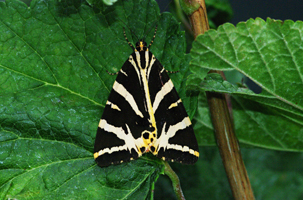 |
|
Jersey Tiger
Euplagia quadripunctaria © photo: Liz Goodyear A member of the Tiger moth family, this species which is a common sight in Europe has in recent years expanded its range from an original small population in South London. Through July to late August, it is now regularly reported from across London and parts of Hertfordshire, occasionally in large numbers and will fly during the day and night. It has a range of herbaceous larval foodplants. |
Scarlet Tiger
Callimorpha dominula © photo: Butterfly Conservation Also a member of the Tiger moth family, but whereas the Jersey Tiger is moving northwards from London - the Scarlet Tiger is colonising southwards from the north of Hertfordshire, with increasing reports each year. It flies from mid June into July, a bit earlier than the Jersey Tiger and will also fly during the day and night. It has a range of herbaceous larval foodplants. |
From May look out for the Mother Shipton and Burnet Companion, both in the family Noctuidae. These brown moths are easily confused with Grizzled and Dingy Skipper butterflies - see Identification of Skippers page.
 |
|
Mother Shipton
Callistege mi © photo: Sandra Standbridge Named because of a resemblance to a portrait of Old Mother Shipton a sixteenth-century soothsayer on each of the forewings and is found in meadows, downland, open woodlands and hedgebanks. Its larvae feed on members of the clover family as well as some grasses and the pupa is a cocoon spun within a twisted grass blade. When disturbed it flies fast and low close to the ground and once settled is difficult to see. |
Burnet Companion
Euclidia glyphica © photo: Trevor Chapman Probably more widespread than the Mother Shipton. It inhabits hedgerows, wet meadows, woodland margins and downland. The larvae feed on members of the clover family including Bird's-foot-trefoil and pupate in a cocoon of silk and plant debris spun on the ground. |
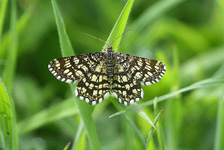 |
Latticed Heath
Chiasmia clathrata © photo: Sandra Standbridge Fairly common in parts of our area, it inhabits downland, embankments, heathland, open woodland and brown field sites but also can be found around Lucerne crops. The larvae feed on Lucerne and various species of clover and trefoil |
There are also some quite small day flying moths including members of the Pyrausta family of micros and two small macro species. The sizes of these smaller moths are very similar and several are flying alongside each other.
Pyrausta aurata
© photo: Andrew Wood This brightly coloured micro moth is always associated with herbs such as mint and marjoram. It can be found in gardens and is often referred to as 'the Mint Moth'. This species is very similar to Pyrausta purpuralis and care needs to be taken identifying the two. |
Pyrausta nigrata
© photo: Liz Goodyear This distinctive dark micro moth is also associated with herbs such as wild thyme and marjoram which are found on the chalky downland areas of north and west Hertfordshire. It isn't very common and when in flight it is not dissimilar to P. aurata or P. purpuralis but with care the difference should quickly become apparent. |
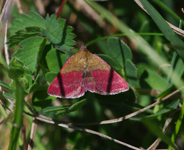 |
|
Small Yellow Underwing
Panemeria tenebrata © photo: Liz Goodyear In May and June this macro moth can be found in grassy areas visting a variety of flowers. It is a small moth with a brown upperwing and yellow underwing which can be seen when it is settled. It is smaller than any butterfly and is most likely to be mistaken for Pyrausta aurata (see above). The Small Yellow Underwing larvae feed on common and field mouse ear |
Small Purple-barred
Phytometra viridaria © photo: Liz Goodyear This pretty little macro moth is a very local species and only recorded on some of the chalky downland sites in Hertfordshire, such as Aldbury Nowers. It can be be found flying between May and July especially if you look very hard up the side of steep chalk slopes. One of the larval plants are the flowers and leaves of Common Milkwort (Polygata vulgaris) |
In June the 'Burnet' moths begin to emerge. Burnets are brightly coloured, black and red, day-flying moths which are attracted to various wild flowers. There are seven species of burnet moth in Britain, two of which are relatively common and widespread in our area. These are the Six-spot Burnet and the Narrow-bordered Five-spot Burnet
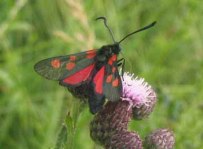 |
||
Six-Spot Burnet
Zygaena filipendulae © photo: Liz Goodyear This moth flies from the end of June to late July, and is the most widely distributed and commonest burnet species. It can be found in a wide variety of habitats, including chalk downs, derelict meadows, waste ground and roadside verges. The larvae feed on Bird's-foot-trefoils, whilst the black pupa can be found enclosed in an opaque cocoon, which varies in colour from bright yellow to dirty white and is attached to grass stems and other vegetation. The adult has 6 red spots on each forewing. |
Narrow-bordered Five-spot Burnet
Zygaena lonicerae © photo: Archie Lang This flies from mid June to late July. It is also fairly widespread, in our area. The larvae are known to feed on various clovers. This species also has black pupa enclosed in transparent cocoons attached to grass stems but these tend to vary from pale whitish-yellow or greenish-yellow to white. The adult has 5 spots on each wing, with the single spot near the wing tip. People often confuse the Narrow-bordered Five-spot Burnet with the very similar Five-spot Burnet Zygaena trifolii. |
 |
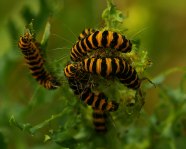 |
The Cinnabar
Tyria jacobaeae Adult © photo: Andrew Wood & Larvae © photo: Liz Goodyear Another cause of confusion is with this black and red species often encountered during the day but which is in the family Arctiidae with footman and tigers. The Cinnabar is not strictly a day-flying moth either but is easily disturbed from rest in long vegetation during the day. Its larvae are the familiar yellow and black devourers of Ragwort Senecio jacobea. This species is also widely distributed in England, flying from May to July and inhabiting meadows and wasteground where the foodplant is abundant. |
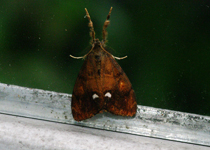 |
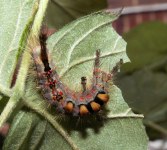 |
The Vapourer
Orgyia antiqua Adult © photo: Liz Goodyear & Larvae © photo: Clare Gray From July until October this can be a common day-flying moth although only the male is seen flying as the female is flightless. The male flies fast and often quite high along lines of trees and hedges seeking out a female, and is often confused with members of the Hairstreak family of butterflies. The female does not move from her pupal case and can be found on twigs or fences surrounded by groups of several hundred eggs. The caterpillar is red and back with pale yellow tufts and very distinctive and can be found on many wild and cultivated plants. |
There are also some unusual and rarer day-flying moths to be found
Chimney Sweeper
Odezia atrata © photo: Liz Goodyear This unusual almost black moth apart from the white edges flies in June. This is a very local species in our area found mostly just south of the M25 in north London. Two of the best sites where it will be encountered are Trent Park and Forty Hall, both in north Enfield. It has also been recorded in north Hertfordshire Its larval foodplant is Pignut Conopodium majusa, a small umbellifer type plant. It is an extremely difficult moth to photo! |
Four-spotted
Tyta luctuosa © photo: Liz Goodyear This moth is a UK Priority Species and is currently only found in the north of Hertfordshire east of Royston, near to the Essex/Cambridgeshire border. The moth normally flies from around the end of May until near the end of June with a second generation later in July. It's larval food plant is Field Bindweed (Convolvulus arvensis) - a seemingly common 'weed' but the moth must have very specific requirements otherwise the species would be widespread. Please visit the Four-spotted Survey page for more information. |
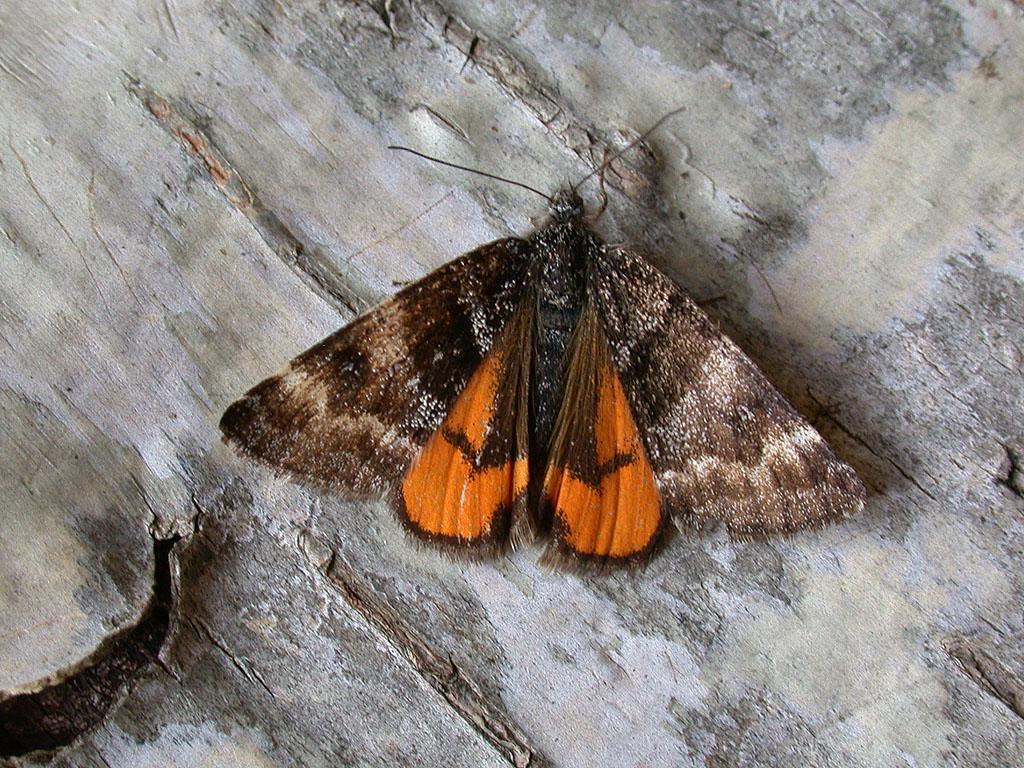 |  |
Orange Underwing
Archiearis parthenias © photo: Helen Bantock | Light Orange Underwing
Archiearis notha © photo: Chris Benton |
Both these species have an almost identical appearance, similar habits and flight period but Orange Underwing larvae are supposed to be restricted to birch Betula pendula and Light Orange to aspen Populus tremula.
They both fly in bright sunshine mainly at tree top height from mid March to April. Its only when one is encountered on the ground that they are noticed - their chocolate coloured upper wings and orange underwing make them quite distinctive if one descends to ground level. Both species have been seen drinking from mud puddles.
Both species are probably under recorded as they are the first day-flying moths of the year and recorders aren't usually looking up into the tree-tops. However, great care must be taken to separate these two species, as they can be flying alongside each other and it is only the careful examination of the undersides that can tell them apart although only the male Light Orange Underwing has a feathered antennae. Currently there is some debate that the two species use both foodplants so that the presence of only one of the larval foodplants can't make identity certain. It is possible that some early records of Small Copper butterflies are misidentified Underwings!
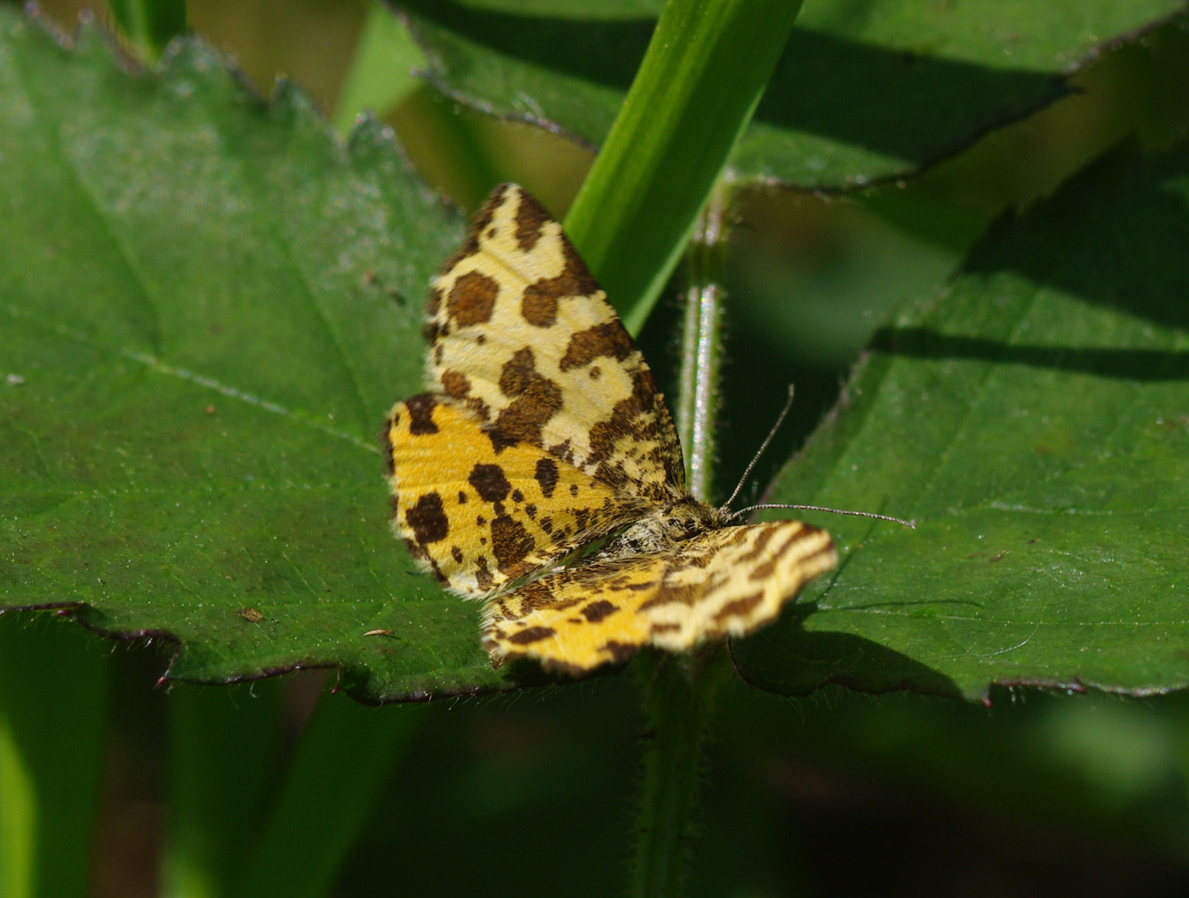 |
Speckled Yellow Pseudopanthera macularia © photo: Liz Goodyear (left) & Liz Goodyear (right) |
This attractive moth flies from mid May to the end of June. This is a very local species in our area since it prefer sunny rides in older woods, such as the Broxbourne Woods complex. The larval food plant is mainly Wood Sage (Teucrium scorodonia).
Several other moths will be encountered during the day by disturbing vegetation including various Carpets and Shaded Broad-bar but these are not day-flying species although are still worthy of a record.